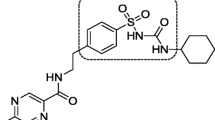Summary
A comparison was made between the binding of the anti-arrhythmic agents aprindine and moxaprindine to human serum, to human serum albumin (HSA), to α1-acid glycoprotein (α1-AGP) and to a mixture of HSA and α1-AGP. In serum from healthy volunteers (n=4) the binding of aprindine-HCl 5 µg/ml (13.8 µM) was 93.8% (SD±1.0), and that of moxaprindine-HCl 5 µg/ml (12.8 µM) was 94.1% (SD±1.1). Their binding to the mixture of α1-AGP and albumin approximated their binding to serum. For α1-AGP, the binding was similar for both compounds, whereas for HSA the binding of aprindine was more pronounced than that of moxaprindine: for both products the affinity coefficient for binding to α1-AGP was about 100 times greater than that for binding to albumin. In serum from rheumatoid patients and from patients with renal failure a small but significant increase in binding of aprindine and moxaprindine was observed, approximately 1%. Increased and decreased binding was seen in serum from cirrhotic patients; for example, for aprindine the range in cirrhosis was 96.7%–79.8%, and the range in controls was 95.0%–92.4%. Free drug fraction and α1-AGP concentration were inversely correlated. The results show that α1-AGP plays an important role in the binding of aprindine and moxaprindine, and that alteration in the binding of the two compounds in disease states to a large extent can be explained by changes in serum α1-AGP concentration.
Similar content being viewed by others
References
Piafsky KM, Borgä O (1977) Plasma protein binding of basic drugs. II. Importance of α1-acid glycoprotein for interindividual variation. Clin Pharmacol Ther 22: 545–549
Borgä O, Piafsky KM, Nilsen OG (1977) Plasma protein binding of basic drugs. I. Selective displacement from α1-acid glycoprotein by tris (2-butoxyethyl) phosphate. Clin Pharmacol Ther 22: 539–544
Piafsky KM, Borgä O, Odar-Cederlöf I, Johansson C, Sjöqvist F (1978) Increased plasma protein binding of propranolol and chlorpromazine mediated by disease-induced elevations of plasma α1-acid glycoprotein. N Engl J Med 299: 1435–1439
Schneider RE, Bishop H, Hawkins CF, Kitis G (1979) Drug binding to α1-glycoprotein. Lancet 1: 554
Scott BJ, Bradwell AR, Schneider RE, Bishop H (1979) Propranolol binding to serum orosomucoid. Lancet 1: 930
Glasson S, Zini R, D'Athis P, Tillement JP, Boissier JR (1980) The distribution of bound propranolol between the different human serum proteins. Mol Pharmacol 17: 187–191
Brinkschulte M, Breyer-Pfaff U (1980) The contribution of α1-acid glycoprotein, lipoproteins, and albumin to the plasma binding of perazine, amitriptyline, and nortriptyline in healthy man. Naunyn Schmiedeberg's Arch Pharmacol 314: 61–66
Belpaire FM, Bogaert MG, Rosseneu M, Teirlynck O (1981) Binding of β-adrenoceptor antagonists to human serum albumin, α1-acid glycoprotein and human serum. Br J Clin Pharmacol 11:125P
Andreasen F, Husted S, Jakobsen P, Jensen EB (1980) The binding of aprindine to serum proteins with statistical considerations concerning the analysis of binding data. Acta Pharmacol Toxicol 46: 105–112
de Suray JM, Lavis A, Breekpot F (1981) Pharmacokinetic study of aprindine and moxaprindine in dogs. Int J Clin Pharmacol Ther Toxicol 19: 209–215
Rosenthal ME (1967) A graphic method for the determination and presentation of binding parameters in a complex system. Anal Biochem 20: 525–532
Chio LF, Oon CJ (1979) Changes in serum alpha1 antitrypsin, alpha1 acid glycoprotein and beta2 glycoprotein in patients with malignant hepatocellular carcinoma. Cancer 43: 596–604
Van Durme JP, Bogaert MG, Rosseel MT (1974) Therapeutic effectiveness and plasma levels of aprindine, a new antidysrhythmic drug. Eur J Clin Pharmacol 7: 343–345
Waleffe A, Guillaume D, Mary-Rabine L, Kulbertus H (1980) The efficacy of intravenous moxaprindine on ventricular ectopic activity. Acta Cardiol 35: 257–268
Author information
Authors and Affiliations
Rights and permissions
About this article
Cite this article
Teirlynck, O., Belpaire, F.M. & Andreasen, F. Binding of aprindine and moxaprindine to human serum, α1-acid glycoprotein and serum of healthy and diseased humans. Eur J Clin Pharmacol 21, 427–431 (1982). https://doi.org/10.1007/BF00542331
Received:
Revised:
Accepted:
Issue Date:
DOI: https://doi.org/10.1007/BF00542331




